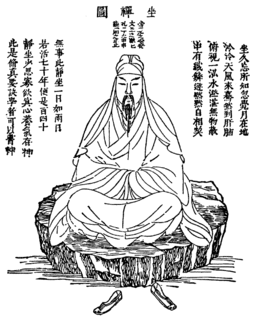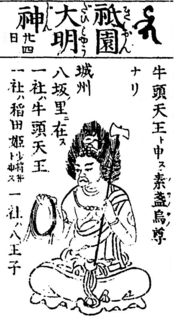
Shinto is a religion from Japan. Classified as an East Asian religion by scholars of religion, its practitioners often regard it as Japan's indigenous religion and as a nature religion. Scholars sometimes call its practitioners Shintoists, although adherents rarely use that term themselves. Shinto has no central authority in control and much diversity exists among practitioners.

Buddhism has been practiced in Japan since about the 6th century CE. Japanese Buddhism created many new Buddhist schools, and some schools are original to Japan and some are derived from Chinese Buddhist schools. Japanese Buddhism has had a major influence on Japanese society and culture and remains an influential aspect to this day.

Shugendō is a highly syncretic religion, a body of ascetic practices that originated in the Nara Period of Japan having evolved during the 7th century from an amalgamation of beliefs, philosophies, doctrines and ritual systems drawn from local folk-religious practices, Shinto mountain worship and Buddhism. The final purpose of Shugendō is for practitioners to find supernatural power and save themselves and the masses by conducting religious training while treading through steep mountain ranges. Practitioners are called Shugenja or Yamabushi. The mountains where shugenja practiced were all over Japan, and include various mountains of the Ōmine mountain range such as Mount Hakkyō and Mount Ōmine.

Shinbutsu-shūgō, also called Shinbutsu-konkō, is the syncretism of Shinto and Buddhism that was Japan's only organized religion up until the Meiji period. Beginning in 1868, the new Meiji government approved a series of laws that separated Japanese native kami worship, on one side, from Buddhism which had assimilated it, on the other.

The Japanese term shinbutsu bunri (神仏分離) indicates the separation of Shinto from Buddhism, introduced after the Meiji Restoration which separated Shinto kami from buddhas, and also Buddhist temples from Shinto shrines, which were originally amalgamated. It is a yojijukugo phrase.

Honzon, sometimes referred to as a Gohonzon, is the enshrined main image or principal deity in Japanese Buddhism. The buddha, bodhisattva, or mandala image is located in either a temple or a household butsudan.

Buddhism has interacted with several Eastern religions such as Taoism, Shintoism and Bon since it spread from the Indian subcontinent during the 2nd century AD.

Ōmura Sumitada was a Japanese daimyō lord of the Sengoku period. He achieved fame throughout the country for being the first of the daimyo to convert to Christianity following the arrival of the Jesuit missionaries in the mid-16th century. Following his baptism, he became known as "Dom Bartolomeu". Sumitada is also known as the lord who opened the port of Nagasaki to foreign trade.

In Buddhism, faith refers to a serene commitment to the practice of the Buddha's teaching and trust in enlightened or highly developed beings, such as Buddhas or bodhisattvas. Buddhists usually recognize multiple objects of faith, but many are especially devoted to one in particular, such as one particular Buddha. Faith may not only be devotion to a person, but exists in relation to Buddhist concepts like the efficacy of karma and the possibility of enlightenment.

Haibutsu kishaku (廃仏毀釈) is a term that indicates a current of thought continuous in Japan's history which advocates the expulsion of Buddhism from Japan. More narrowly, it also indicates a particular historic movement and specific historic events based on that ideology which, during the Meiji Restoration, produced the destruction of Buddhist temples, images and texts, and the forced return to secular life of Buddhist monks. It is a yojijukugo phrase.
The term honji suijaku or honchi suijaku (本地垂迹) in Japanese religious terminology refers to a theory widely accepted until the Meiji period according to which Indian Buddhist deities choose to appear in Japan as native kami to more easily convert and save the Japanese. The theory states that some kami are local manifestations of Buddhist deities. The two entities form an indivisible whole called gongen and in theory should have equal standing, but this was not always the case. In the early Nara period, for example, the honji was considered more important and only later did the two come to be regarded as equals. During the late Kamakura period it was proposed that the kami were the original deities and the buddhas their manifestations.

The term shinbutsu kakuri in Japanese Buddhist terminogy refers to the tendency in medieval and early modern Japan to keep some kami separate from Buddhism. While some kami were integrated in Buddhism, others were kept systematically away from Buddhism. This phenomenon had significant consequences for Japanese culture as a whole. It should not be confused with shinbutsu bunri or with haibutsu kishaku, which are phenomenons recurrent in Japanese history and usually due to political causes. While the first assumes the acceptance of Buddhism, the second and third actually oppose it.
Mark J. Teeuwen is a Dutch academic and Japanologist. He is an expert in Japanese religious practices, and he is a professor at the University of Oslo. In a 2002 essay called From Jindō to Shinto: A Concept Takes Shape, he traced the evolution of the term "Shinto" from the reconstructed pronunciation Jindō at the time of the Nihon Shoki until today, describing the changes its meaning has gone through.
Toshio Kuroda was a Japanese academic, historian and university professor. A specialist in medieval Japanese history and in the history of Japanese thought, he greatly influenced Japanese historiography with several innovative and controversial theories. His ideas were the opposite of what mainstream academics at the time believed, and for this reason his name is often at the center of controversies. His work has been called "seminal", "epochal" and "revolutionary". Kuroda's analysis of religion and of its significance is Marxist.

Myōken, also known as Sonjō-Ō, is a Buddhist deification of the North Star worshiped mainly in the Shingon, Tendai and Nichiren schools of Japanese Buddhism.
William M. Bodiford is an American professor and author. He teaches Buddhist Studies and the religion of Japan and East Asia at the University of California, Los Angeles.
Hongaku is an East Asian Buddhist doctrine often translated as "inherent", "innate", "intrinsic" or "original" enlightenment and is the view that all sentient beings already are enlightened or awakened in some way. It is closely tied with the concept of Buddha-nature.
Hibutsu are Japanese Buddhist icons or statues concealed from public view. Hibutsu are generally located within Buddhist temples in shrines called zushi. They are generally unavailable for viewing or worship, although they are brought out for specific religious ceremonies; it is also possible in some cases for the hibutsu to be viewed in exchange for an offering to the temple. Certain hibutsu, such as the wooden statue of Gautama Buddha at Seiryō-ji or the Amida statuary at Zenkō-ji, are almost never displayed, even to initiates of the temples in which they are held. Others are put on public display only rarely, in a ceremony called kaichō.
Bernard Faure is a Franco-American author and scholar of Asian religions, who focuses on Chan/Zen and Japanese esoteric Buddhism. His work draws on cultural theory, anthropology, and gender studies. He is currently a Kao Professor of Japanese Religion at Columbia University and an Emeritus Professor of Religious Studies at Stanford University. He also previously taught at Cornell University, and has been a visiting a professor at the University of Tokyo, the University of Sydney, and the École Pratique des Hautes Études in Paris. He co-founded the Center for Buddhist Studies at Stanford University and the ARC: Asian Religions and Cultures Series within Stanford University Press. He is also the founder and co-director of the Columbia Center for Buddhism and East Asian Religions (C-BEAR). His work has been translated into several Asian and European languages.

The Gion cult (祇園信仰) is a Shinto cult. Originally it revolved solely around Gozu Tenno, but during the Separation of Shintoism and Buddhism of the Meiji era the government mandated it shift to revolving around Susanoo.












